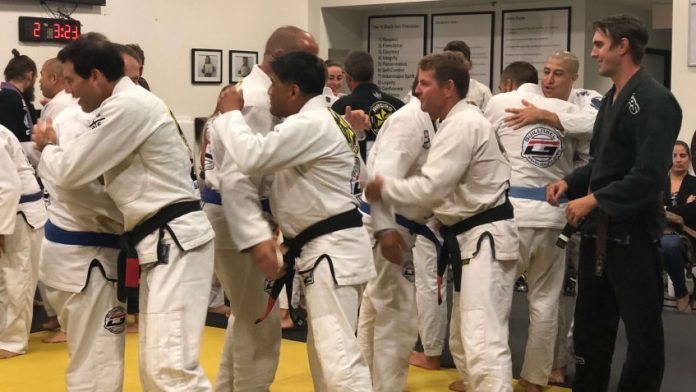
When I talk to people that are new to Brazilian Jiu-Jitsu, one of the things I see surprises them most is the approach to grading. They seem very surprised at the lack of ceremonies and tests when it comes to receiving your next belt. Okay, stripes are less important and not such a big deal after a while. A BJJ belt, however, is always aa big deal. So people end up surprised at how laid back the approach to grading is. How come they just tie a belt around your waist? Isn’t there a demonstration I need to do? I, for one, love this approach and wouldn’t change it. From white all the way to BJJ black belt, this is how things are done in most academies. However, is there any merit to actually testing for belts? If so, how exactly do we approach testing a BJJ black belt?
Getting a black belt in Brazilian Jiu-Jitsu is just like graduating from a difficult university. Nope, I stand corrected, it is much harder. And, I can pinpoint one thing that actually makes BJJ harder than learning at school – exams. To be more precise, the lack of exams. The way Jiu-Jitsu is usually set up, you can’t really rely on luck to pass an exam and get the next belt. Imagine a BJJ black belt who has sneaked through belt testing an is actually barely at the purple belt level? That’s bad for the sport, the person carrying the belt and all potential students. But is completely shunning tests the right way to go about things?
BJJ Belt Promotions
I guess one reason why the approach to grading in BJJ is different from other martial arts is the belt system, to begin with. Kids belt aside (and testing, we’ll talk about that in a different article), there are 5 adult belts. Ther go from white, through blue, purple and brown, all the way to BJJ black belt. After black, you have a couple of coral belts and a red belt, but I guess those “grandmaster” ones are beyond testing scope anyways.
In terms of getting a belt in BJJ, the usual reference is a promotion. IN essence, these are “special” classes in most academies, just because instructors like to do it all at once. With academies that don’t have their main professor training there, these is usually done in a seminar or camp style of event. In other academies, instructors just call up people randomly at the end of class when they feel they deserve to get to the next level. As such, there are two main indicators of progress in JIu-Jitsu, at least when it comes to visual cues.
- Every belt has a black are on one end. This is where the stripes go, usually white in color. Every belt has four stripes before you can go to the next belt. Or so was the original idea. Nowadays, people progress at different rates given how many different types of people train. That means that some people get two or three stripes directly, or get the next belt wit just three stripes. Moreover, the approach of tying a belt around someone’s waste allows for a lot of leeways. With the right instructor, this is a proven method of promoting people only when they derive it. However, so much freedom does bring about some misconduct as well.
Do We Need Testing For Belts?
One of the ideas behind promoting people on the spot, without making to much of a fuss or testing is to really be sure that they’re at a certain level. To that extent, instructors get to watch everyone train, roll, compete, interact with others, perhaps help with teaching, etc. In my opinion, there’s no better way to get a correct view of where people are in their BJJ journey. However, some people think that testing is the right way to go. And among those, there are standouts like Gracie family members that swear by testing for belts.
Speaking of tests, I’ve never had to do one. However, there are different types of tests, as far as I could gather from doing research and talking to people. In certain academies, testing is mandatory, even for BJJ black belts. That said, the approach I found most common is actually one of two things.
The first is getting people to showcase what they can do in “reality”. That means shark tanks of students in question in the middle with fresh partners coming in every round for a roll. This usually goes on for an hour or more, with no rest for those looking to get promoted. It does test technical knowledge, resilience, mental strength and so on. That said, it usually involves higher-level guys rolling with the “candidates” in order to really push them.
The other type of belt testing is the more traditional one. Those that are ready to go to the next belt, get to demonstrate a set of techniques and/or flows to show how much they know. In this case, the focus is on pure technical knowledge, usually without any rolling or faster-paced exchanges. It is not something too common to BJJ, but still, there are world-class academies that use this type of approach. That said, both approaches have their merits if we’re being honest. The real question is, whether or not they fit into the world of JIu-Jitsu?
BJJ Black Belt Tests
I guess we could agree that whether or not colored belts get tested is pretty much insignificant. It is still the professor’s call whether or not someone will get the chance of promotion. However, how do we approach BJJ black belt promotions? After all, there’s the fact that getting a BJJ black belt is aking to graduating from a university. It does take the better part of a decade, if not more for the average grappler to get a BJJ black belt. And I’m talking about dedicated, at least three times a week type of training. That’s a wealth of experience right there. Plus, as they say, if you’re doing something for more than 10 years, you become an expert at it.
Royce Gracie is one example of a Professor that does mandatory testing for his black belts. They do have quite a lot to demonstrate, plus go for rolls with world-class grapplers. Other gyms, like SBG for example, also test everyone. In the case of Thornton’s gym, though, it is the nastiest shark tank you’ll lever come across when a BJJ black belt promotion is at hand. However, I still think lots of it is unnecessary.
The real question here is whether or not someone is a legitimate BJJ black belt or not? The only way to know for sure is to know their lineage. Whether or not you test a grappler after ten years of regular training, they’re going to be at the black belt level. You can go froth with tests and other useless ceremonies, or just give them what they deserve. On the other hand, no amount of testing, regardless of the outcome, can justify giving someone a black belt before they deserve it. McDojos are notorious for it, taking away a lot of credibilities, testing or not.
Closing Thoughts
Unfortunately, in this modern world of grappling it, is not as much about getting a BJJ black belt, but rather getting a legitimate one. Of course, most instructors take black belts very seriously, and people that get the mare legit. For me, testing is redundant, as there’s no way an hour or more can paint a real picture of how much someone knows. Jiu-Jitsu is a lifetime thing, and promoting someone when they derve it, focusing on the fact they reach the next level rather than exams or competition – intensity rolling sessions is what I prefer. Let’s keep it laid back, and honor those that have gotten a BJJ black belt by not treating them as kids that train karate.


![Darce Choke Encyclopedia – Origins, Mechanics and Variations [2025] BJJ, choke, Brabo, BJJ Darce Choke, D'arce Choke, Darce BJJ Choke](https://bjj-world.com/wp-content/uploads/2017/11/JungPoirierLeeYahoo-218x150.jpg)









![No-Gi Grapplers Guide To Front Headlock Joel Bane DVD Review [2025] No-Gi Grapplers Guide To Front Headlock Joel Bane DVD Review](https://bjj-world.com/wp-content/uploads/2025/03/no-gi-front-headlock-joel-bane-dvd-review-218x150.png)

![Get Off My Legs Gringo Craig Jones DVD Review [2025] Get Off My Legs Gringo Craig Jones DVD Review](https://bjj-world.com/wp-content/uploads/2025/03/get-off-my-legs-gringo-craig-jones-dvd-review-218x150.png)

![Leg Lock Entries Helena Crevar DVD Review [2025] Leg Lock Entries Helena Crevar DVD Review](https://bjj-world.com/wp-content/uploads/2025/03/leg-lock-entries-helena-crevar-dvd-review-218x150.png)
![Special K Guard Neil Melanson DVD Review [2025] Special K Guard Neil Melanson DVD Review](https://bjj-world.com/wp-content/uploads/2025/03/special-k-guard-neil-melanson-dvd-review-218x150.png)


![Leg Locks From Beginner To Advanced Dan Manasoiu DVD Review [2024] Leg Locks From Beginner To Advanced Dan Manasoiu DVD Review](https://bjj-world.com/wp-content/uploads/2024/12/leg-locks-from-beginner-to-advanced-dan-manasoiu-dvd-review-100x70.png)


![Compass Kneebar System Charles Harriott DVD Review [2024] Compass Kneebar System Charles Harriott DVD Review](https://bjj-world.com/wp-content/uploads/2024/11/compass-kneebar-system-charles-harriott-dvd-review-100x70.png)


![Master The Move The American Lock John Danaher DVD Review [2024] Master The Move The American Lock John Danaher DVD Review](https://bjj-world.com/wp-content/uploads/2024/12/the-american-lock-john-danaher-dvd-review-100x70.png)
![Knee Lever John Wayne Sweep Adam Wardzinski DVD Review [2024] Knee Lever John Wayne Sweep Adam Wardzinski DVD Review](https://bjj-world.com/wp-content/uploads/2024/12/john-wayne-sweep-adam-wardzinski-dvd-review-100x70.png)

![Leg Lock Strategies: Navigating Entanglements Jack Stapleton DVD Review [2024] Leg Lock Strategies: Navigating Entanglements Jack Stapleton DVD Review](https://bjj-world.com/wp-content/uploads/2024/12/navigating-entanglements-jack-stapleton-dvd-review-100x70.png)


![Complete Front Headlock System Michael Pixley DVD Review [2024] Complete Front Headlock System Michael Pixley DVD Review](https://bjj-world.com/wp-content/uploads/2024/10/front-headlock-system-michael-pixley-dvd-review-100x70.png)





![Master The Move Anaconda Strangle John Danaher DVD Review [2025] Master The Move Anaconda Strangle John Danaher DVD Review](https://bjj-world.com/wp-content/uploads/2025/02/anaconda-strangle-john-danaher-dvd-review-100x70.png)


![Roger Gracie Closed Guard System DVD Review [2025] Roger Gracie Closed Guard System DVD Review](https://bjj-world.com/wp-content/uploads/2025/01/roger-gracie-closed-guard-system-dvd-review-100x70.png)
![Mastering Takedown Prevention Steve Mocco DVD Review [2024] Mastering Takedown Prevention Steve Mocco DVD Review](https://bjj-world.com/wp-content/uploads/2024/11/mastering-takedown-prevention-steve-mocco-dvd-review-100x70.png)
![Shoulder Lock Mastery Zach Green DVD Review [2025] Shoulder Lock Mastery Zach Green DVD Review](https://bjj-world.com/wp-content/uploads/2024/12/shoulder-lock-mastery-zach-green-dvd-review-100x70.png)
![Master Scissor Sweep Ryan Scialoia DVD Review [2025] Master Scissor Sweep Ryan Scialoia DVD Review](https://bjj-world.com/wp-content/uploads/2024/12/scissor-sweep-ryan-scialoia-dvd-review-100x70.png)
![Back Control and Submission Felipe Pena DVD Reveiw [2025] Back Control and Submission Felipe Pena DVD Reveiw](https://bjj-world.com/wp-content/uploads/2025/01/back-control-and-submission-felipe-pena-dvd-reveiw-100x70.png)
![Assassin Choke Baret Yoshida DVD Review [2024] Assassin Choke Baret Yoshida DVD Review](https://bjj-world.com/wp-content/uploads/2024/10/assassin-choke-baret-yoshida-dvd-review-100x70.png)